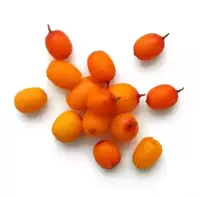Berry loch

The loch ("Elaeagnus") is not any one defined plant, but a plentiful genus of shrubs and trees that belong to the Loch family. According to rough estimates, today it has 50-70 species of loch, which grow mainly in China, Japan and Europe. In our country, in natural conditions, you can find only 1 species of this plant - Loch narrow-leaved (Elaeagnus commutata).
Basically, mentioning the loch, they mean primarily its fruits - red-orange drupes with powdery pulp, sweet to taste, and elliptical bone. The berry of the narrow-leaved loch is eaten, as a rule, fresh. Nevertheless, it is often used as a biologically active additive, which is part of bread, various cereals and other dishes. In addition, curative infusions and decoctions are often made from loch berries, the use of which has a beneficial effect not only on certain human organs, but also on the entire body.
The garden form of this plant, which is called the Bukhara jida, is also known. It is a small tree or shrub that is cultivated in order to obtain rather small, tart-sweet fruits that knit a little. They are eaten similarly to the berry of the loch.
It is noteworthy that in folk medicine, not only the loch berry itself is valued, but also all other parts of this plant - useful substances are included not only in its fruits, but also in flowers, leaves, bark and resin. In particular, the berry of the loch contains a large amount of carbohydrates, natural dyes, tannins, organic acids, phosphates and potassium salts. The leaves of the plant are rich in vitamins C and E, and the flowers are unusually fragrant essential oil.
Narrow-leaved loch berry, along with the rest of its parts, is used as a natural antibacterial, antiviral and astringent agent that helps with various inflammatory processes. Infusions and decoctions and leaves of the loch have an antipyretic effect - they are advised to be taken with fever and colds, as well as osteochondrosis, gout and rheumatism.
The use of loch berries has a beneficial effect on the state of the nervous system, contributes to improving memory, facilitating the course of malaria. It is characterized by diuretic and exhilarating effects. In addition, the loch berry is a general tonic and tonic that is recommended for diseases of the cardiovascular system. The decoction prepared from dried berries of the loch is often used for colitis and diarrhea.
loch 34 kCal berries
The energy value of the berry is loch (Ratio of proteins, fats, carbohydrates - ju):
Proteins: 0.2 g (~ 1 kCal)
Fats: 0.1 g (~ 1 kCal)
Carbohydrates: 7.9 g (~ 32 kCal)
Energy ratio (bj | y): 2% | 3% | 93%
 Español
Español Français
Français Português
Português Русский
Русский 简体中文
简体中文 繁體中文
繁體中文 日本語
日本語 한국어
한국어 العربية
العربية Türkçe
Türkçe Қазақ
Қазақ Deutsch
Deutsch Italiano
Italiano Українська
Українська
